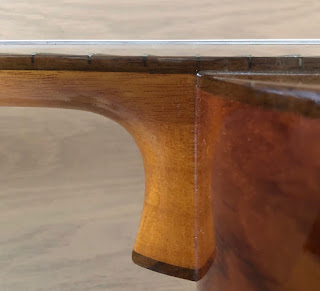Als je wat langer als fanatiek gitarist met het vliegtuig
gaat reizen dan is een TRAVEL gitaar welke simpel te
monteren en demonteren is, een must, zeker als hij mee
de vliegtuigcabine in mag als handbagage. Daarom ben
ik een prototype aan het ontwikkelen en er worden nog
steeds handigheidjes aan toegevoegd
De hals is dus afneembaar van de massief houten body.
Dat kan met het losdraaien van maar 1 schroef omdat de
hals aan de body wordt vastgemaakt door deze in een
uitsparing te schuiven met een zwaluwstaart constructie.
De hals kan niet weg en er kan zelfs een ingebouwde
speling voor de actie van deze gitaar worden inge-
bouwd. Geheel nieuw is de demontabele en soms ook
inklapbare versie niet maar de alternatieven zijn
voor de gemiddelde gitarist die ook graag reist een
beetje aan de prijzige kant. Zeker als het incidenteel
gebruik betreft.
Eigen ervaring leert dat de steunen voor de rechter arm
en linker bovenbeen (resp. links en rechts op de foto)
verstelbaar moeten zijn. Moet ook weer simpel met een
stelschroef te realiseren zijn, vind ik.
Bedoeling is eigenlijk om de gitaar op een versterker aan te
kunnen sluiten of liever nog via een bluetooth constructie
draadloos te kunnen bespelen met behoud van een goed
geluid op elk niveau. Dat wordt het volgende project.
I took the neck from a damaged guitar I was able to
buy for very little money. Besides the neck I used some
other parts as well: Both supports for knee and arm rest
have been made out of the sides. I constructed this
guitar for use on our holidays in Greece as more than
8 days without a guitar, hmm....
For the body I used a block of mahogany that in fact is quite
heavy but once the neck has been attached the balance has to
be there of course. An under saddle pick up is the next expe-
riment. Thus it can be amplified and with the Gibson Chet
Atkins classical electric guitar in mind this whole set up
might sound in a good way as well. Gibson also used a solid
magogany body for their first Chet Atkins classical models.
Later they chambered that body in order to make it a bit
lighter and give it more resonance.
The back of the whole construction makes it clear. A
detachable neck, fastened wit only one screw. No more
will be necessary here as I used a so called swallow
tail construction. It can even be possible now to have
the highest part of the fretboard glued onto the body
thus creating an even shorter neck that as a whole
and thus can be carried with a person into the airplane
cabine. The knee support can be placed in the right
position depending on the length of the player.
Sandpaper has been used to have that support
sticked in the position wanted.
The right arm rest on a normal classical guitar is in line
with the soundboard. Therefor the right arm rest support
has been mounted from the front. More options are
possible of course but I made the length of it according
to my likings.
These supports have been made out of the side of this rather cheap
guitar. But I took three pieces and glued them together in order to
make it more sturdy and reliable.
As most classical guitar necks have an inner heel and enough
wood it is quite easy to model that part to fit the wood block
that serves as a new guitar body. For transport it is best to
disassemble the unit beforehand. But that involves only
removing the three screws, fitted with one and the same
Allan Wrench key.






















